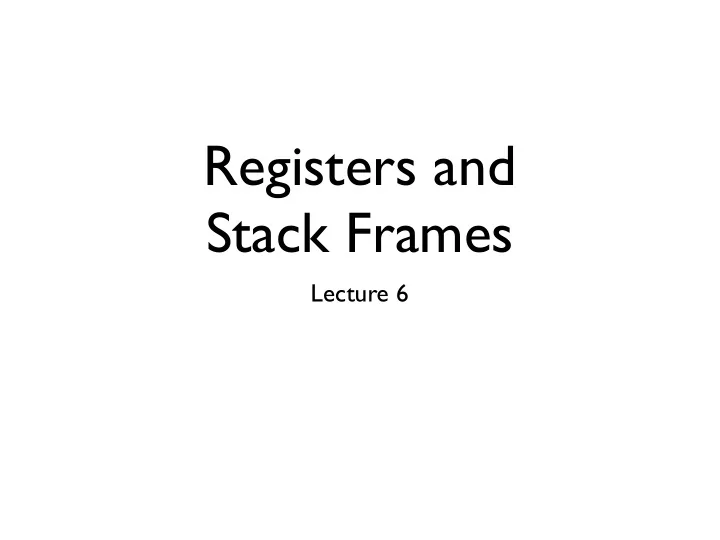

Registers and Stack Frames Lecture 6
Function calls and stack frames • function invocation contexts are strictly nested • stack mechanism is adequate for managing parameters and locals • Information needed for function calls • arguments • in registers • in memory (via stack) • function return address • return values? • local variables of the function • temp space for saving registers
MIPS Registers Hardware Name Description $0 zero constant zero $1 at assembler temporary $2-$3 v0-v1 function return value $4-$7 a0-a3 incoming args $8-$15 t0-t7 temporaries $16-$23 s0-s7 callee-saves temporaries $24-$25 t8-t9 temporaries $26-$27 k0-k1 exception handling $28 gp global data pointer $29 sp stack pointer $30 s8,fp frame pointer $31 ra return address
Stack Frame Layout higher addresses previous frame fp local variables saved registers tk... caller saves sn... callee saves ra fp a0-a3 additional a6 outgoing args a5 sp next frame
Assembly Example 1 .text .globl main main: subu $sp,$sp,24 # stack frame is 6 words sw $ra,20($sp) # save return address sw $fp,16($sp) # save frame pointer addu $fp,$sp,20 # set new frame pointer li $a0,6 # arg0: 6 jal f # call f move $a0,$v0 # arg0: return value from f jal print_int # call print_int lw $ra,20($sp) # restore return address lw $fp,16($sp) # restore frame pointer addu $sp,$sp,24 # pop current frame j $ra # return to caller
Assembly Example 2 .text f: subu $sp,$sp,32 # allocate new frame (8 words) sw $ra,20($sp) # save return address sw $fp,16($sp) # save previous frame pointer addu $fp,$sp,28 # define new frame pointer sw $a0,0($fp) # store n lw $v0,0($fp) # load n into v0 bgtz $v0,$L2 # branch to $L2 if n > 0 li $v0,1 # otherwise, return 1 j $L1 # jump to return code $L2: lw $v1,0($fp) # load n into v1 subu $a0,$v1,1 # a0 := v1 - 1 (= n - 1) jal f # call f recursively lw $v1,0($fp) # load n into v1 mul $v0,$v0,$v1 # v0 := f(n-1) * n $L1: lw $ra,20($sp) # restore return address lw $fp,16($sp) # restore frame pointer addu $sp,$sp,32 # pop frame frome stack j $ra # return to caller (main)
Example frame f called from within g (main) g frame sp g fp f = sp f - 28 n = 0($fp) n fp f padding ra g f frame fp g a3 a2 a1 sp f sp f = sp g + 32 a0 Stack pointer must be aligned on two word boundary.
Escaping Variables type tree = {key: string, left: tree, right: tree} function prettyprint(tree: tree) : string = let var output := "" function write(s: string) = output := concat(output,s) function show(n: int, t: tree) = let function indent(s: string) = (for i := 1 to n do write(" "); output := concat(output,s); write("\n")) in if t=nil then indent(".") else (indent(t.key); show(n+1,t.left); show(n+1,t.left)) end An escaping variable is a local variable of a in show(0,tree); function that occurs in the body of a nested output function definition. E.g. output, n. end
Computing Escaping Variables • An escaping variable must be declared before the nested function that it appears in. • The escaping property can be determined by comparing the function nesting depth of the variable’s declaration with the nesting depths of its applied occurrences. • The escaping property is recorded in the escape field (a bool ref ) of the abstract syntax construct that declares it. - VarDec for variable declarations - ForExp for for loop index variables - field record for function parameters • An environment can be used to record function nesting depth and escape field ref for each variable within its scope.
Static Links • To access an escaping variable while executing the body of a nested function that accesses it, we will use a static link . • A static link is the frame pointer of a frame (function activation record) for the latest call of the function statically enclosing the function currently being called. • The static link will be passed as an added parameter, conventionally as the first parameter (a0). • To access an escaping variable more than one nesting level deep, we need to follow a chain of static links.
Static Links Example function prettyprint(tree: tree) : string = let var output := "" function write(s: string) = output := concat(output,s) function show(n: int, t: tree) = prettyprint let function indent(s: string) = (for i := 1 to n output sl 1 do write(" "); output := concat(output,s); show write("\n")) n in if t=nil then indent(".") t sl 2 else (indent(t.key); show(n+1,t.left); n indent show(n+1,t.left)) output s end i sl 3 in show(0,tree); output output write end s
Frames for Tiger signature FRAME = sig type frame type access val newFrame : {name: Temp.label, (* label of called fun *) formals : (bool * string) list} -> frame (* formals specified with an escape flag, and a description * string *) val name : frame -> Temp.label (* the function label of a frame *) val formals : frame -> access list (* access info for formal parameters *) val allocLocal : frame -> (bool * string) -> access (* more to come ... *) end (* signature FRAME *)
Frame Layout (2) higher addresses previous frame fp escaping arguments local variables saved registers ra fp tk... caller saves sn... callee saves overflow a6 outgoing args a5 sp next frame
Incoming Arguments function f(x0,x1,x2,x3,y4,y5) = let function g(u: int): int = x0 + x2 + u /* x0 and x2 escaping */ in g(3) end Arguments x0,...,x3 start in registers $a0,...,$a3. They are moved to temp registers or frame slots: x0:$a0 ⇒ 0($fp) -- escaping previous frame higher addresses x1:$a1 ⇒ t 17 y5 y4 x2:$a2 ⇒ -4($fp) -- escaping fp x0 x3:$a3 ⇒ t 18 x2 ra saved registers fp Arguments y4,y5 are stored in previous frame: sp y4: 4($fp) y5: 8($fp) next frame
Recommend
More recommend